- Quick Read
- Deep Read ( 7 Min. )

Why is Christian Science in our name?
Our name is about honesty. The Monitor is owned by The Christian Science Church, and we’ve always been transparent about that.
The Church publishes the Monitor because it sees good journalism as vital to progress in the world. Since 1908, we’ve aimed “to injure no man, but to bless all mankind,” as our founder, Mary Baker Eddy, put it.
Here, you’ll find award-winning journalism not driven by commercial influences – a news organization that takes seriously its mission to uplift the world by seeking solutions and finding reasons for credible hope.
Explore values journalism About usIn Today’s Issue
- Russian POWs recount horrific cost of battling dug-in Ukrainians
- Today’s news briefs
- Can $18 billion in opioid settlement funds turn an overdose tide? Ask North Carolina.
- In Nigeria, anti-government protests unite a divided country
- A different gold medal – for gentile diplomats who quietly saved Jews
- How surfing helped me conquer corporate burnout
Monitor Daily Podcast
- Follow us:
- Apple Podcasts
- Spotify
- RSS Feed
- Download
TODAY’S INTRO
New pockets of people power
Discontent can be unifying, even transformative.
A week ago today in this space, my colleague Amelia Newcomb set the table for a midweek story from Bangladesh on how an interim government there was riding into power on a wave of public anger over economic inequality, bringing hope.
Today we report from Nigeria. A sense of injustice over rising food and transportation costs there – amid government spending many see as self-serving – has long simmered in the streets. It’s growing. A spirit of solidarity and cooperation now overrides old enmities. Like hope, it may prove to be an irrepressible force.
Share this article
Link copied.

Help fund Monitor journalism for $11/ month
Already a subscriber? Login

Monitor journalism changes lives because we open that too-small box that most people think they live in. We believe news can and should expand a sense of identity and possibility beyond narrow conventional expectations.
Our work isn't possible without your support.
Russian POWs recount horrific cost of battling dug-in Ukrainians
The path of two prisoners of war, from induction in Russia to captivity in Ukraine, was arduous, filled with broken promises, insufficient training, and poor equipment. But having survived, they offer insight into Russia’s brutal, yet effective, battle plan.
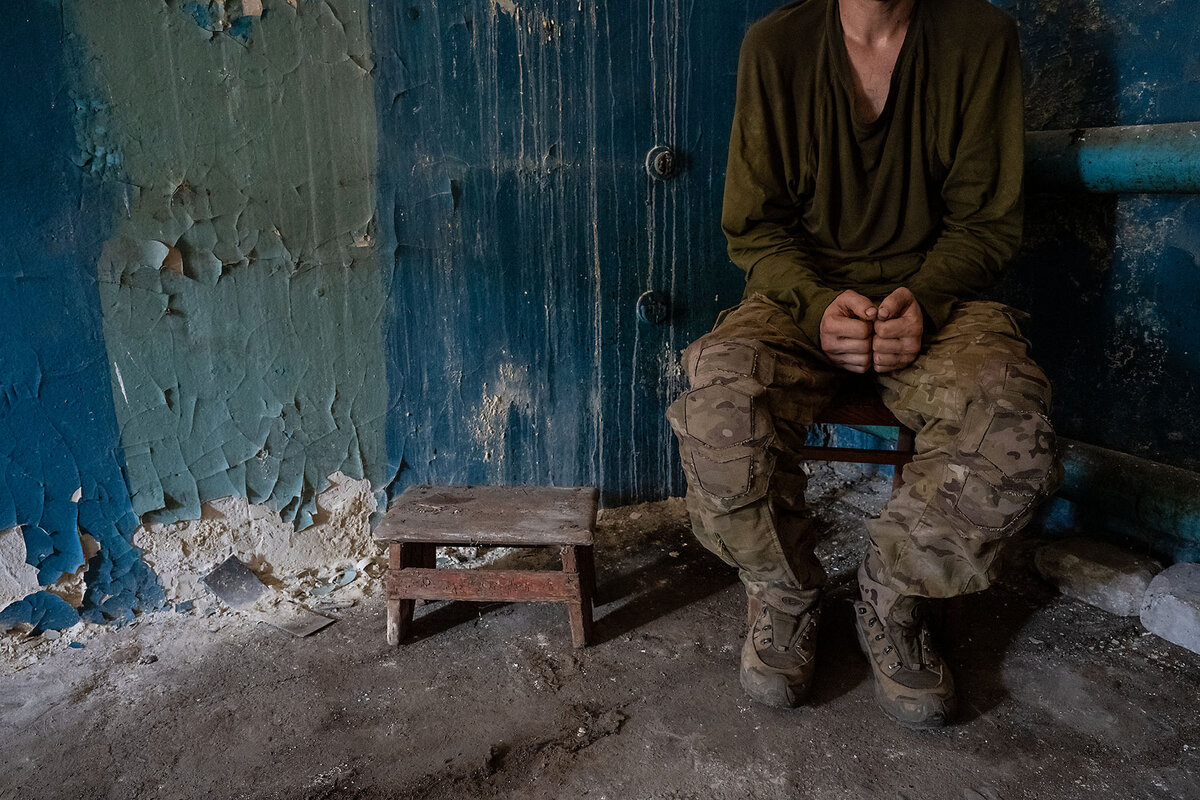
Nothing prepared the Russian soldier for the brutal reality of combat he experienced this summer in eastern Ukraine – nor for the “meat assault” he was ordered to lead.
The soldier, who gives the name Sergei, and is now a prisoner of the Ukrainians, recalls being shocked by the visibly high cost of small battlefield gains: dead Russian and Ukrainian soldiers everywhere.
The apocalyptic scene was a far cry, he says, from the army recruiter’s promise that he would be assigned a safe job inside Russia, on border patrol. Instead, with little training, he was ordered to lead a squad across open ground against dug-in Ukrainian troops.
The Monitor interviewed two Russian prisoners of war as Russian forces made small but steady advances along the entire eastern front. The stark picture they present is necessarily one fragment of the Russian military effort, which has leveraged its manpower advantage by throwing troops at Ukrainian lines in costly waves.
Sergei says he refused to lead the attack, arguing that it was a “suicide mission.” He was sent on it anyway, with this threat ringing in his ears: “‘If you come back,’” he says his commander warned him, “‘I will kill you myself.’”
Russian POWs recount horrific cost of battling dug-in Ukrainians
Nothing prepared the Russian soldier for the violent, brutal reality of combat he experienced this summer in eastern Ukraine – nor for the “meat assault” he was ordered to lead.
The soldier, who gives the name Sergei, arrived at the front in late June, in a town freshly occupied by Russia. He recalls being shocked by the visibly high cost of small battlefield gains: dead Russian and Ukrainian soldiers littering the streets.
The apocalyptic scene was a far cry, he says, from the promise of his army recruiter that he would be assigned a safe job inside Russia, on border patrol.
Instead, wearing a uniform with sewn-in knee pads that he had to purchase himself – and with little training and an abusive commander – he was ordered to lead a squad across open ground against Ukrainian troops entrenched in a forest line.
“The first thing I felt was fear,” says the 30-something Russian soldier, now a prisoner of the Ukrainians, with a tremble of emotion in his voice at the memory. “When I saw what that village looked like, I was terrified.”
When the order came to attack soon after his arrival, “no one wanted to go,” recalls Sergei. “We were pushed by our commanders, ‘Just go, go, go forward.’ They would not let us go back ... even though we knew we were having huge losses. They were using us as meat.”
Of the 14 men in Sergei’s unit, six died and seven were wounded in just five days.
Sergei says he refused to lead the attack, arguing that it was a “suicide mission.” He was sent on it anyway, though not as the squad leader, with this threat ringing in his ears: “‘If you come back,’” he says his commander warned him, “‘I will kill you myself.’”
During that assault, a shell landed on a dugout the Russians were in, breaking one soldier’s leg. Sergei says he stayed with the wounded man for a day while the others fled. Radio calls for help went unanswered.
Eventually Sergei laid down his gun, removed his grenades and magazines of bullets, and stood up with hands raised. He walked toward Ukrainian lines, shouting, “I give up!”
Grateful to be alive
In July, The Christian Science Monitor interviewed two Russian prisoners of war captured separately days earlier in eastern Ukraine, as Russian forces made small but steady advances along the entire eastern front. They were forlorn and looked lost, but also expressed appreciation that they were still alive, when so many of their fellow Russian soldiers were not.
Their stories provide rare insight into the Russian side of the front lines. They describe low levels of motivation to fight and low morale, 2 1/2 years after Russia’s invasion.
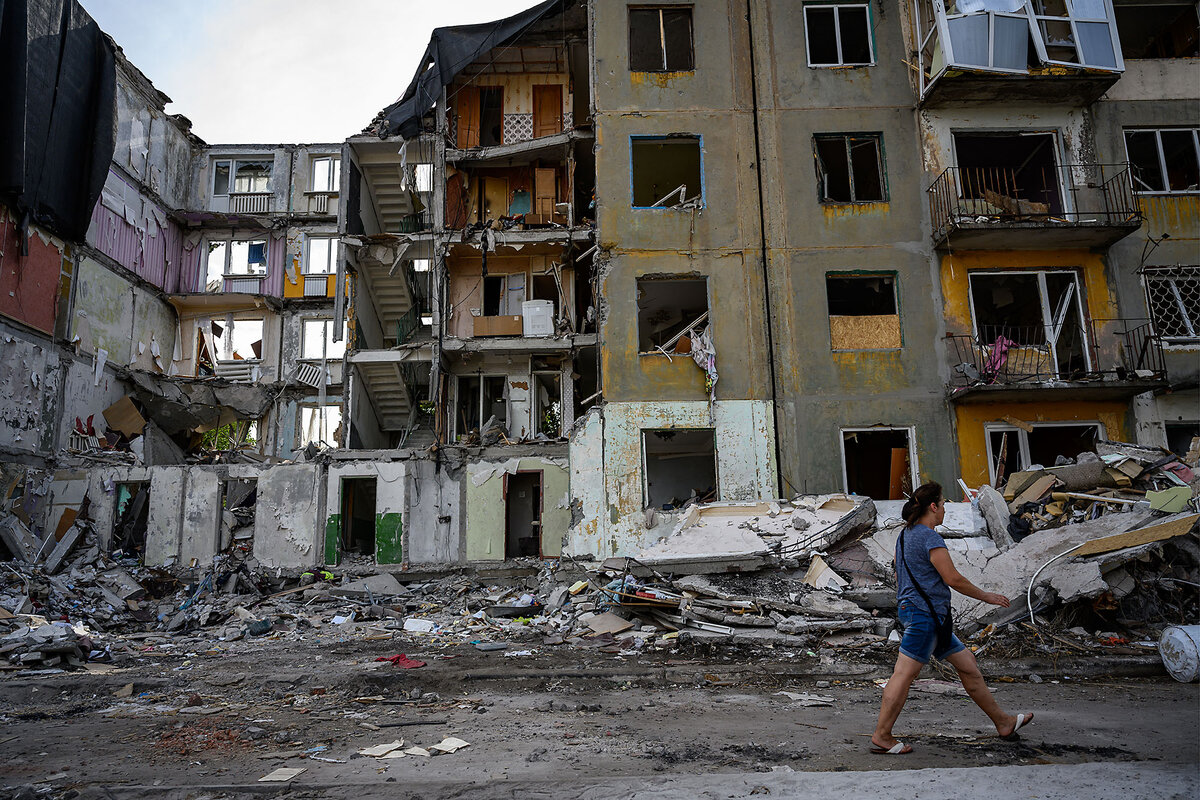
Ukrainian intelligence officers brought both men, whose hands had been taped over their faces during transport behind tinted windows on public roads, and unbound them for lengthy interviews in an abandoned garage in eastern Ukraine.
Neither Russian POW appeared to have suffered any physical harm in captivity, though the right knee of one soldier, who gives the name Arsen, was evidently wounded and bandaged. That happened before his capture, he says.
Nor did the prisoners appear to speak under duress, though Ukrainian officers remained in the room throughout the interviews.
The Monitor is not publishing the Russian soldiers’ full names or other identifying details, in keeping with guidelines in the Geneva Conventions that prohibit public disclosure of such information.
The stark picture these first-time soldiers present of life and death in the Russian trenches is necessarily one fragment of a much broader mosaic of the Russian military effort. A large Russian offensive toward Kharkiv failed in May, for example.
But all along the front, Russia also continues to achieve incremental gains by leveraging its manpower advantage – and by throwing troops at Ukrainian lines in costly waves, known by both sides as “meat assaults.”
Trapped on “a one-way road”
That was where Sergei found himself in late June, caught in a collapsed bunker where, he says, he “knew it was the end.”
“The first thing I was told was, ‘Don’t give up, you will surely be killed, and it is better to die fighting,’” says the Russian prisoner, wearing a soiled dark green sweater and boots with the laces removed, his fingers stained with dirt.
“Of course, along the way we met some people who had high spirits, and they were even ready to fight,” recalls Sergei. “But the moment they got here ... they realized this was just a one-way road.”
“I don’t think there is a chance for Russia to win this war,” he says.
“I just hope that, sooner or later, this will bring all our [Russian] nation an understanding that a terrible thing is going on, we are paying a huge price, the suffering is enormous, and we have a lot of dead people,” says Sergei.
“I hope people will understand that, and turn off those televisions, that news, because there is a catastrophe going on,” the prisoner says. “There are not unlimited human resources we have in Russia – huge numbers of people are dying.”
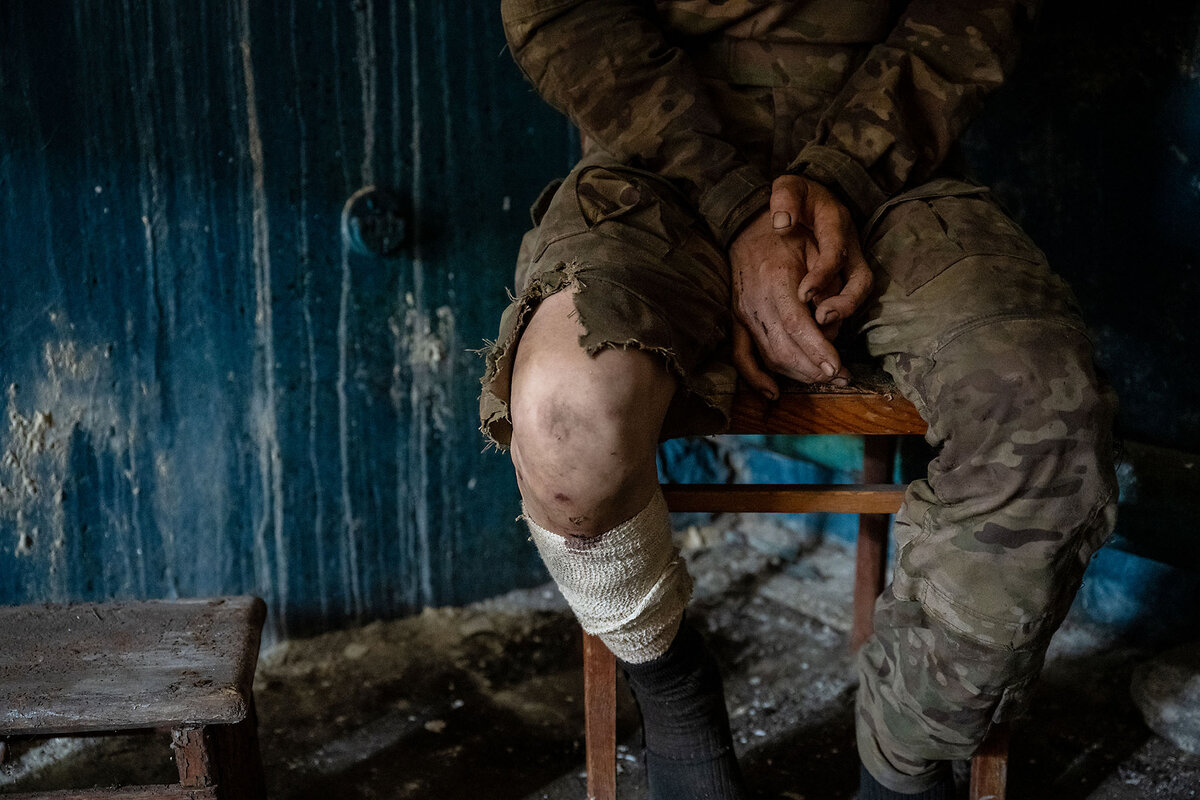
Britain’s Ministry of Defence calculates that Russia has lost well over 1,000 soldiers per day, dead or wounded, throughout May, June, and July. The volume of Russian troops has piled “pressure” onto Ukrainian lines, it said, but “an effective Ukrainian defense and lack of Russian training reduces Russia’s ability to exploit any tactical successes.”
Videos filmed by Russian soldiers and circulating online include one seven-minute film, apparently taken after the capture of Avdiivka in February. In the video, a Russian soldier walks along an exposed, postbattle trench line that he calls a “road of death,” due to the trail of dead soldiers in the mud every few feet.
Two weeks of training, and rusty rifles
Russian prisoner of war Arsen says he had higher expectations of the Russian army – fed by propaganda TV reports about the war – than “meat assaults.” When he signed up in January, he was told that he would be posted in a rear “backup” position, digging trenches.
Arsen was given two weeks of “good training,” he says, about how to assault trenches, lay mines, and demine territory, as well as perform basic first aid. And then a truck arrived to outfit the unit, loaded with rifles that were old and rusty, and body armor that was dirty and sometimes riven with bullet holes.
“It was like a process of disappointment,” says Arsen, his fingers toying with the torn threads of his trousers, cut above the bandage on his shin. He limps when he moves, and wears no boots, but only a pair of black socks on his feet.
“None of the people I was with had the spirit to fight,” says Arsen. “Just before this task [order to advance], a lot of people refused and were beaten.”
Russian officers would single out wavering foot soldiers for a “preventive talk,” he says, which often included beating with sticks, though he was not beaten himself.
Instead, when ordered to run to join fellow Russian soldiers at a front-line dugout at night, Arsen inadvertently ran too far, directly into Ukrainian positions. When he heard the Ukrainians shout, he realized his mistake.
“I was very surprised they didn’t shoot me immediately,” says Arsen, a tear at the memory mingling with sweat and rolling down his nose in the hot room.
“I don’t really think Russia can succeed in [Ukraine]; their only tactic is these assaults,” says Arsen. “What impressed me was the weakness of the Russian forces – it is not what we see on Russian TV. If I will go back [to Russia], it is better to sit in prison than to come back here and fight.”
One Ukrainian intelligence officer, who was in the room during the interviews with the Russians, says he is wary about reading too much benefit for Ukraine in the descriptions of a Russian front-line defined by lack of morale and sparse training.
“It doesn’t give us a lot of inspiration, because there are still a lot of them [Russian soldiers], and still they are motivated by fear [and] they will be shot” if they retreat, says the intelligence officer, when asked later about their statements.
“Sometimes an [anti-Ukraine] ideology is driving people, but not often,” he says of Russian soldiers. “If 10 unprepared people are shooting at you, one will get you. It’s a very simple tactic. They must take the position, or they are done. They can’t come back.”
Oleksandr Naselenko supported reporting for this story.

Today’s news briefs
• Eyes on Venezuela: An International Criminal Court prosecutor says the ICC is “actively monitoring the present events” there. Security forces in the Latin American nation launched a crackdown on the opposition after its disputed presidential election.
• Hong Kong convictions: The Court of Final Appeal upholds the convictions of seven of Hong Kong’s most prominent pro-democracy activists over their roles in one of the biggest anti-government protests in 2019.
• Trial begins in reporter’s killing: Jury selection is set to start Aug. 12 for the murder trial of Las Vegas-area politician Robert Telles, who has pleaded not guilty in the September 2022 stabbing death of reporter Jeff German.
• Top Hawaii Democrat loses primary: Hawaii’s House Speaker Scott Saiki loses to Kim Coco Iwamoto, a state Board of Education member from 2006 to 2011 who campaigned on tackling corruption in government, and was the highest-ranking openly transgender person elected in the U.S. at the time.
• Disputed Olympic bronze: U.S. Olympic officials say they will appeal a court ruling that resulted in American gymnast Jordan Chiles being asked to return the bronze medal she won in the Paris Olympics floor exercise.

Can $18 billion in opioid settlement funds turn an overdose tide? Ask North Carolina.
To address America's opioid crisis, health care experts recommend a priority on preventing fatal overdoses in the short term while helping people become sober over time. Money from legal settlements may allow states to do just that.
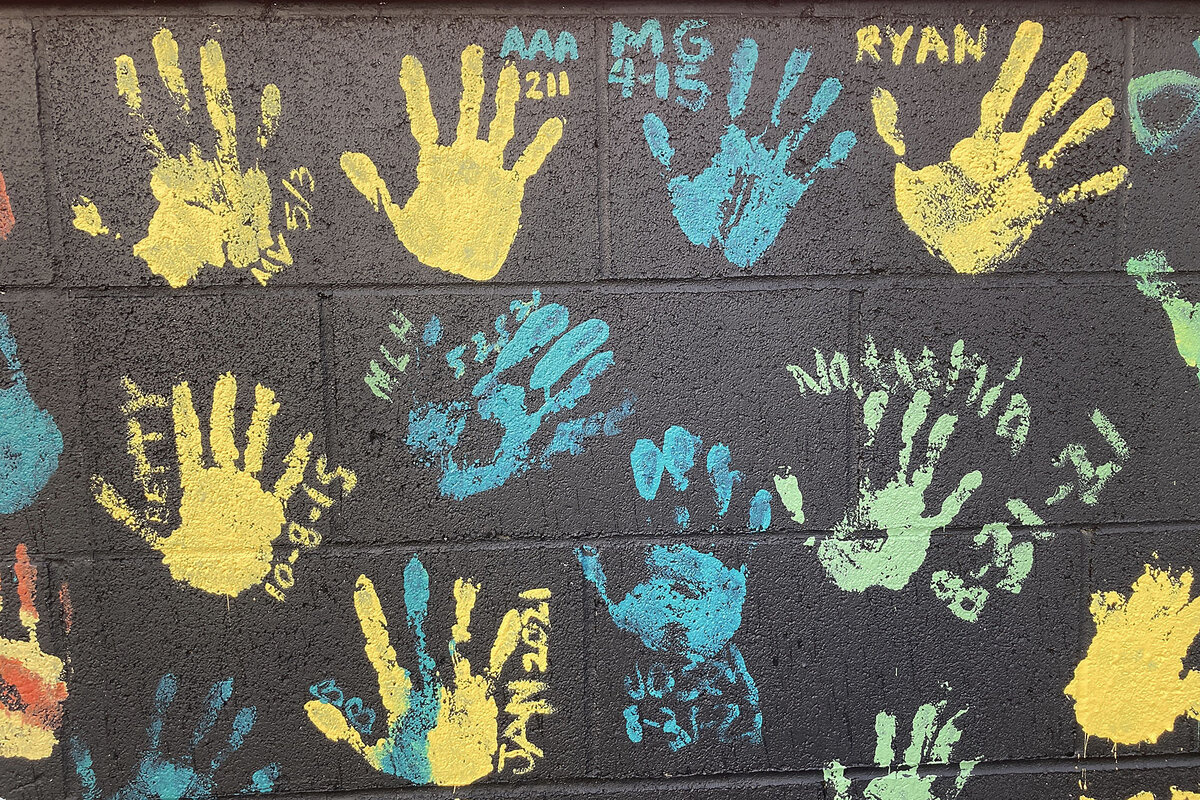
- Quick Read
- Deep Read ( 6 Min. )
America’s opioid crisis has been ravaging the nation for decades, costing states millions of dollars in resources and claiming tens of thousands of lives each year.
But is the tide about to turn? Over the next 18 years, local, state, and tribal governments will receive $18 billion – money from legal settlements with opioid manufacturers and distributors – to be spent on abating America’s opioid epidemic. It could be a defining tool in nationwide efforts to reduce opioid-related deaths – if funds are spent wisely.
While these settlements might be lifesaving, they’re not unprecedented.
North Carolina, for example, a state that negotiated the tobacco Master Settlement Agreement in 1998, required tobacco companies to pay billions of dollars annually to curb tobacco addiction. Although cigarette use has declined, the MSA is broadly considered a failure: The state used the money to plug budget holes.
Now the state with the 12th-highest rate of opioid deaths, North Carolina is hoping to avoid mistakes. National experts are cautiously optimistic.
It’s “a once-in-a-generation opportunity to change the arc of this crisis,” says Brandon Marshall, professor of epidemiology at the Brown University School of Public Health. “We have to get it right.”
Can $18 billion in opioid settlement funds turn an overdose tide? Ask North Carolina.
The opioid crisis has been ravaging the United States for decades, costing states millions of dollars in resources and claiming tens of thousands of lives each year.
But is the tide about to turn? Over the next 18 years, local, state, and tribal governments will receive a total of $18 billion to be spent on abating America’s opioid epidemic. The funds, divided among jurisdictions, are the product of legal settlements with opioid manufacturers and distributors.
The money could be a defining tool in nationwide efforts to reduce opioid-related deaths – if funds are spent wisely.
Sapience won the hard way
While these settlements are potentially lifesaving, they’re not unprecedented. But the precedent – a settlement with tobacco companies in the late 1990s – is more cautionary tale than road map for policymakers across the U.S., particularly in North Carolina.
The Tar Heel State was one of 46 states that negotiated the tobacco Master Settlement Agreement in 1998, which required tobacco companies to pay states billions of dollars annually to help curb tobacco addiction, particularly among youth. But while the funds have been disbursed and cigarette use has declined, the MSA is broadly considered a failure.
With no settlement language requiring states to spend the funds on reducing tobacco addiction, they began using the money to plug budget holes or meet other needs. In North Carolina, the heart of America’s tobacco industry and now the state with the 12th-highest rate of opioid deaths, local leaders are hoping to avoid those mistakes with the new opioid settlement funds.
National experts are cautiously optimistic.
It’s “a once-in-a-generation opportunity to change the arc of this crisis,” says Brandon Marshall, professor of epidemiology at the Brown University School of Public Health who has advised Rhode Island on fund distribution. “We have to get it right.”
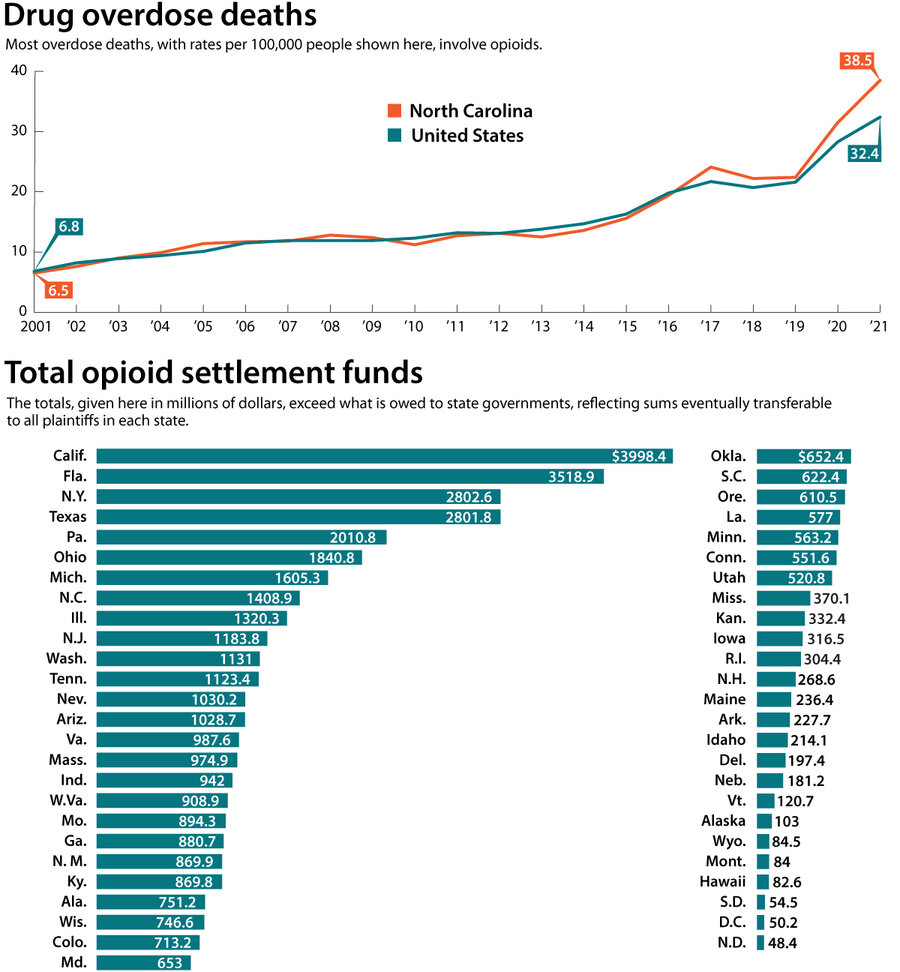
National Center for Health Statistics; North Carolina Department of Health and Human Services; OpioidSettlementTracker.com
Lessons from history
Tobacco’s roots in North Carolina are deep – 200 years deep – and nowhere are those ties stronger than in Durham.
Nicknamed “Bull City” – not for cattle, but for a late-1800s advertising campaign by the Blackwell Tobacco Co. – Big Tobacco’s fingerprints are hard to miss. A thin, Lucky Strike-branded smokestack towers over Durham like a supersize cigarette.
But like most other American cities, Durham has grappled with a different public health crisis in recent years. Drug overdose deaths in Durham County increased each year between 2018 and 2022, according to state data. The county also has one of the highest rates of illicit drug overdose deaths in the state.

The county has already begun approving uses for the opioid settlement funds, and local officials say they are optimistic about positive change over the next two decades.
“We have the best settlement of any state in the United States,” says Wendy Jacobs, a Durham County commissioner.
The options for spending the funds “are evidence-based,” she adds, “and they’re not being diverted like [with] the tobacco settlement.”
In North Carolina, the tobacco MSA funds were partly intended to compensate tobacco farmers for losses and help them transition to new crops. The farmers were given access to $42 million “for modernization and marketing,” according to a 2014 New York Times report. In fiscal year 2021, the state allocated just a tiny fraction – $1.9 million of the $447.4 million it received in settlement funds and tobacco tax revenue – to tobacco use prevention, according to Truth Initiative, a public health nonprofit created as part of the MSA.
North Carolina is far from the only state that has used tobacco MSA funds in this manner.
While the state attorneys general who negotiated the settlement were clear that they wanted the award to address tobacco use, current state legislatures “can’t bind future state legislatures” on how they use funding, says Micah Berman, public health law expert at Ohio State University who has researched the tobacco MSA.
Minnesota, for example, launched an initiative to prevent youth tobacco use in 2000, budgeting $20 million a year for it. But the state Legislature dramatically cut funding for the initiative in 2003.
Just a few years after agreeing to the tobacco settlement, North Dakota had allocated almost half of its settlement funds for infrastructure projects, according to a 2001 report from the U.S. Government Accountability Office. In 2019, the state received $53.6 million from the settlement but allocated just over 10% – only $5.8 million – to tobacco addiction prevention, according to Truth Initiative.
By contrast, most current opioid settlements require that funds be spent on drug addiction treatment and prevention, though they give states flexibility in how they do that.
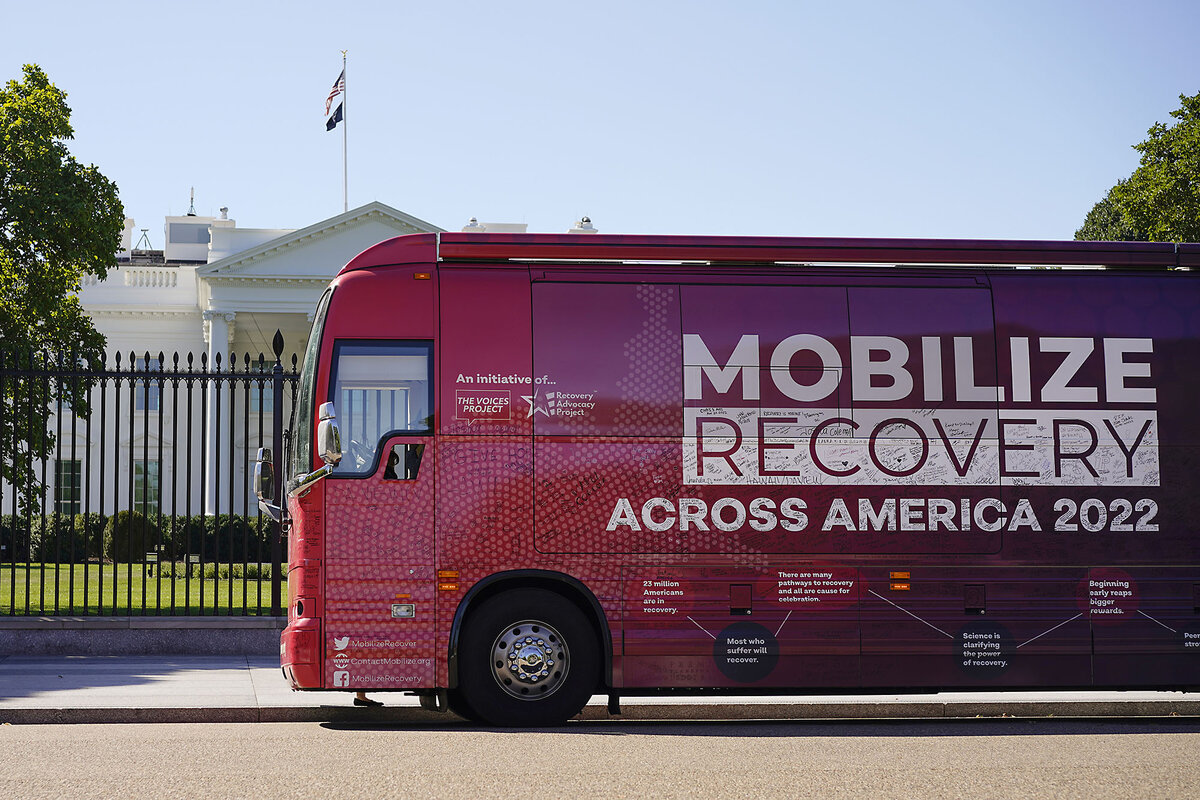
Two options in Tar Heels State
In North Carolina, for example, counties and municipalities get 85% of the $1.5 billion the state will receive over the next 18 years. The state is offering two broad options for how the money can be spent.
Option A allows localities to fund “evidence-based, high-impact strategies” drawn up by the state. With Option B, a local government can design its own funding plan.
Durham County has chosen Option A for the nearly $22 million it expects over the next two decades. The settlement money “has been a way for us to actually continue, and build on, some things that we’ve already been doing,” says Commissioner Jacobs, who helps lead a county task force formed in 2018 to help address the opioid crisis.
For example, a Durham County program that connects people who’ve recently overdosed with a drug overdose survivor was close to running out of grant funding. Over $300,000 of settlement funds have now been approved to keep the program running. Settlement money will also fund naloxone vending machines, which will distribute a free nasal spray that reverses opioid overdoses, in the county detention center, public health department, and central library.
Durham County officials also hope to purchase a machine that can allow drug users to quickly check the composition of their supplies on-site. According to the U.S. Drug Enforcement Administration, the “primary driver” of fatal overdoses appears to be more potent opioids like fentanyl being mixed into other drugs.
Nearby Greensboro has had this machine since 2021. Donated to the North Carolina Survivors Union, the machine uses an infrared light to scan drug samples, revealing in 15 minutes what other drugs may be hidden inside.
Despite being one of the state’s most active addiction treatment organizations, it has received little funding from the county.
“We’ll either close or we’ll get funding,” says Louise Vincent, the executive director of the organization.
“It’s been really upsetting,” she adds. “We’ve got some really cool stuff going on.”
Transparency and accountability
North Carolina is among the states being most transparent about how it is using opioid settlement funds. An online dashboard details which counties have allocated funds and what for, from Alexander County’s $212,000 for a postoverdose response team to Yancey County’s $32,000 for reentry programs.
But there are echoes of the tobacco settlement failures in how some states are managing their opioid funds.
Lack of transparency remains a problem. Ten states report fewer than half of their opioid settlement fund expenditures, according to Opioid Settlement Tracker. Others, while not technically misusing settlement funds, are spending the money in ways that concern addiction experts – including funding law enforcement and abstinence-only programs.
But policing how states spend settlement money is not easy.
“It would take a pretty egregious misuse of funds to spur [some] kind of enforcement action,” says Brown University’s Dr. Marshall. “There’s a difference between inappropriate and ineffective use of funds.”
Many experts and health organizations – including the American Society of Addiction Medicine and the American Medical Association – recommend that states prioritize funding harm reduction. These programs aim to prevent fatal overdoses in the short term while helping people become sober over time.
Jennifer Carroll, a North Carolina State University assistant professor who researches substance use, drug overdose, and drug policy, has been happy to see Durham County do just that.
“That doesn’t mean necessarily I agree with the way every single penny is [being] spent ... but I think here we’re doing pretty OK,” says Dr. Carroll. “We really need to be doing what we know works and knocking off the stuff that we know hurts.”
Editor's note: This story has been updated to correct the name of Louise Vincent.

National Center for Health Statistics; North Carolina Department of Health and Human Services; OpioidSettlementTracker.com

In Nigeria, anti-government protests unite a divided country
Recent anti-government protests united Nigerians across religious and ethnic lines. Now the challenge is how to maintain that solidarity.

- Quick Read
- Deep Read ( 5 Min. )
-
By Innocent Eteng Contributor
Since religious riots tore across the central Nigerian city of Jos two decades ago, its Muslim and Christian residents have largely stayed apart. But the cost-of-living crisis that has swept Nigeria over the past year has blurred those boundaries.
“If there is hunger in the land, the hunger that the Christian is feeling is not different from the hunger the Muslim is feeling,” observes Tony Young Godswill, a democracy activist.
So when nationwide anti-government protests began in early August, Jos residents from all backgrounds poured into the streets.
“We are congregated here as Nigerians,” rather than as Christians or Muslims, explains Isa El-Buba, a popular pastor who led the protests. “That shows the spirit of a new Nigeria has come to be.”
Although the protest movement fizzled after only a few days, observers say the solidarity it forged across religious, ethnic, and political fault lines in places like Jos has potential to outlive the demonstrations themselves. A shared distrust of the government – whether in Nigeria, Bangladesh, or Venezuela, where anti-government protests have also recently broken out among a wide range of citizens – is also a fragile form of unity.
Whether it translates into longer-lasting political and social solidarity remains to be seen.
In Nigeria, anti-government protests unite a divided country

Since religious riots tore across the central Nigerian city of Jos two decades ago, its Muslim and Christian residents have largely kept apart. They have their own neighborhoods. They vote for different political parties.
But the cost-of-living crisis that has swept Nigeria over the past year has blurred some of those boundaries. “If there is hunger in the land, the hunger that the Christian is feeling is not different from the hunger the Muslim is feeling,” observes Tony Young Godswill, national secretary of the Initiative for a Better and Brighter Nigeria, a pro-democracy group.
So when nationwide anti-government protests broke out in early August, hungry, angry Jos residents from all backgrounds poured into the streets. And the momentum of the demonstrations soon barreled across old fault lines. When Muslim demonstrators knelt to pray on a busy road one Friday afternoon, hundreds of Christian marchers spontaneously formed a tight, protective circle around them.
“I saw what I never believed I could ever see in Jos,” says Isa El-Buba, a popular pastor who led the protests. “These young people spoke with one voice.”
Although the protest movement fizzled after only a few days, observers say the solidarity it forged across religious, ethnic, and political fault lines in places like Jos has the potential to outlive the demonstrations themselves. A shared distrust of the government – whether in Nigeria, Bangladesh, or Venezuela, where anti-government protests have also recently broken out among a wide range of citizens – is also a fragile form of unity.
The “widespread sense of injustice could be quite combustible,” says Chidi Anselm Odinkalu, a professor of practice in international human rights law at Tufts University and former chair of Nigeria’s National Human Rights Commission.
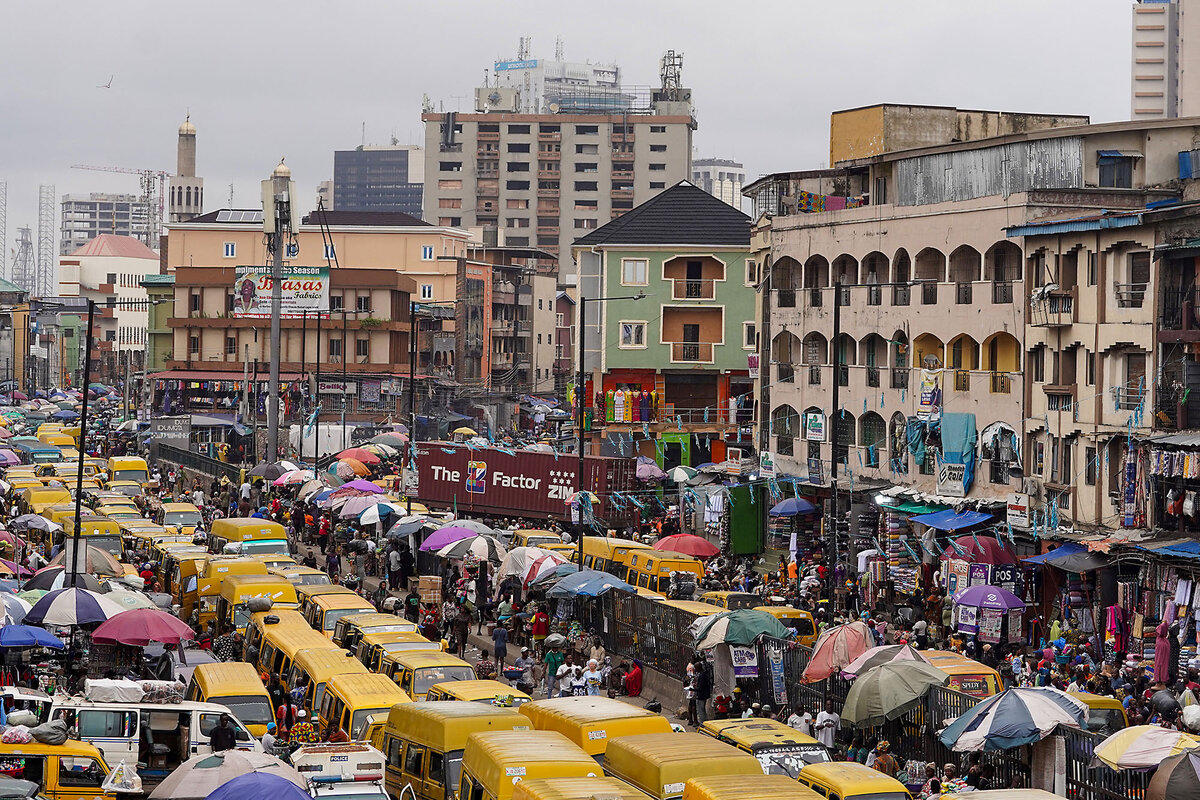
Crisis, hashtag, protest
Nigeria’s protests began in response to the soaring costs of food and transport over the past year and a half, which have more than doubled in some cases. The situation has helped push more than 10 million additional Nigerians into poverty, according to the World Bank. Protesters blame the economic stabilization policies of President Bola Tinubu, which have included removing a heavy subsidy on petrol and devaluing the naira, Nigeria’s currency.
His administration has pleaded for patience from Nigerians during the growing pains caused by these economic reforms. But at the same time, Mr. Tinubu’s administration has cut massive checks for a new presidential yacht, new SUVs for legislators, and a new vice presidential residence. It has also increased the number of ministers by 11, raising many eyebrows.
“I feel very angered to see myself and the masses who have voted for this government suffer,” explains Buhari Shehu, a lawyer who participated in the protests in Jos. He says prices are so unstable that “you can’t even predict” what you will be able to afford on your next trip to the grocery store. “You go to the market and find out things have skyrocketed and that money [you have] is not enough,” he says.
In July, inspired by the success of anti-tax protests in Kenya, Nigerians began to mobilize on the social platform X and other social media sites under the hashtag #EndBadGovernance.
They called for a 10-day national protest demanding reinstatement of the petrol subsidy and a reduction in government spending. In response, Mr. Tinubu announced that he was more than doubling the country’s minimum wage, to 70,000 naira monthly, or around $60.
But it was not enough. On August 1, mass demonstrations broke out in more than two dozen cities across Nigeria.
As in Jos, demonstrators in several cities also bonded across typical fault lines. In politically and religiously polarized states like Kaduna, Lagos, and Osun, Christian demonstrators also stood guard while their Muslim counterparts observed their Juma’at Friday prayers.
In Abuja, the capital, Ibrahim Abdullahi was among those who marched, chanting, “No food! No security! No good life in our country!” As a Muslim, he says he previously thought it was inappropriate for him to protest against a fellow Muslim like Mr. Tinubu. Now, he held a placard that read “We regret Tinubu.”
The heavy-handed response of the police also further united demonstrators. Across the country, security forces fired tear gas and, in some cases, live bullets, into the crowds. At least 22 people have died in the demonstrations, according to Amnesty International.
On Sunday, Aug. 4, the president gave a televised address in which he defended the state’s response, saying he had a responsibility to “ensure public order.”
“Our government will not stand idly by and allow a few with a clear political agenda to tear this nation apart,” he said.
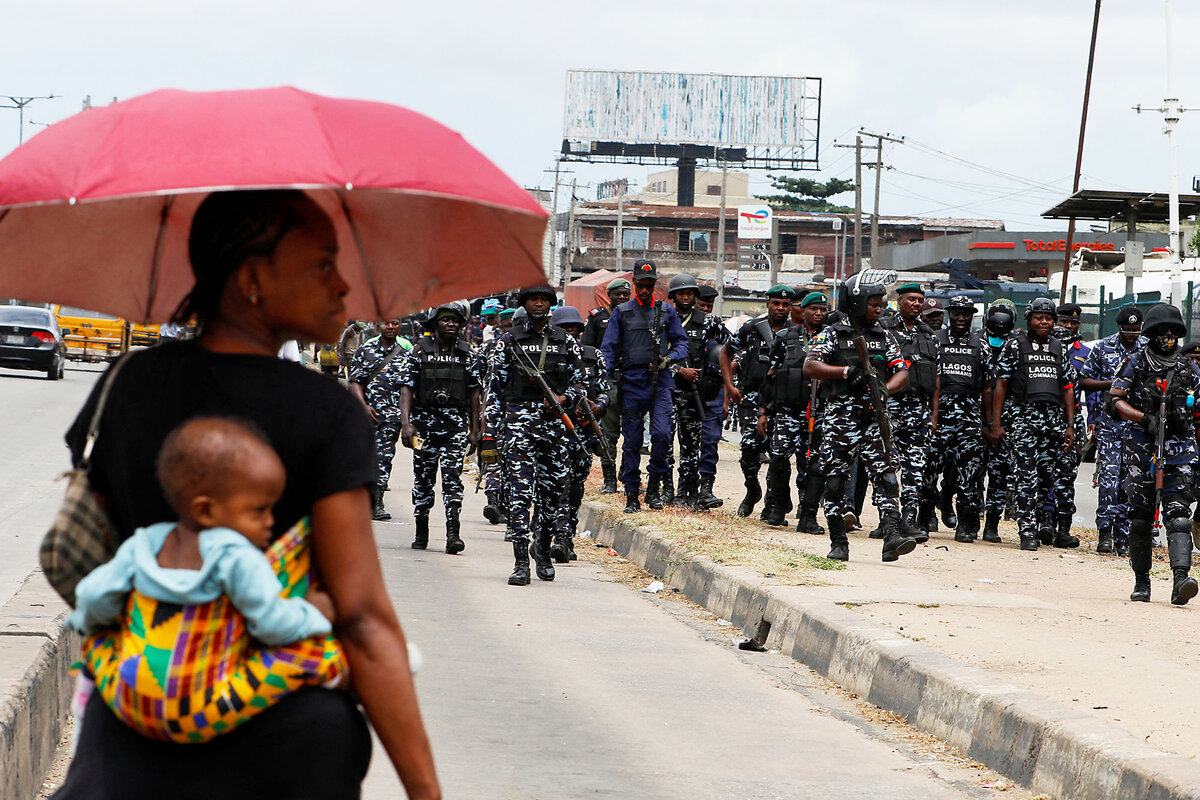
An uncertain future
The police crackdown, coupled with dusk-to-dawn curfews imposed in many states, have dampened the momentum of the demonstrations.
Over the course of the planned 10 days of protests, the numbers of participants dwindled, with only a few dozen people on the streets in major cities by the final day, Saturday, Aug. 10.
But experts and some participants believe that the current moment could still be a critical turning point in Nigerian politics.
The demonstrations “indicate a very angry youth population united by hunger and food insecurity,” says Dr. Odinkalu, the human rights expert. “Finding the money to address these issues will be key.” If not, he argues, the country will be “finely poised” for more protests over the next few years.
Already, protesters in cities like Jos have promised to return to the streets once the curfew is lifted unless their demands are met. And their unity has remained unbroken.
The Sunday after the protests began, hundreds of Muslim demonstrators formed their own protective circle around a church service organized at the protest venue in Jos.
The solidarity shown by Christians in the earlier days of the protests “gave us a sense of encouragement and a sense of unity,” explained Sheikh Suleiman Khalid, a Muslim cleric, in a local TV news interview. “When you see someone, you should know he’s human first before his religion. When you have that empathy in your heart, things will work well.”
Mr. El-Buba, the Christian protest leader, agreed.
“We are congregated here as Nigerians,” he explained in the same news segment. “That shows the spirit of a new Nigeria has come to be.”

A different gold medal – for gentile diplomats who quietly saved Jews
A bill in Congress would honor 60 diplomats who helped Jews escape the Holocaust. Amid a spike in antisemitism and a growing generational knowledge gap, proponents say it offers a timely reminder of both the atrocities and selfless heroism of that time.
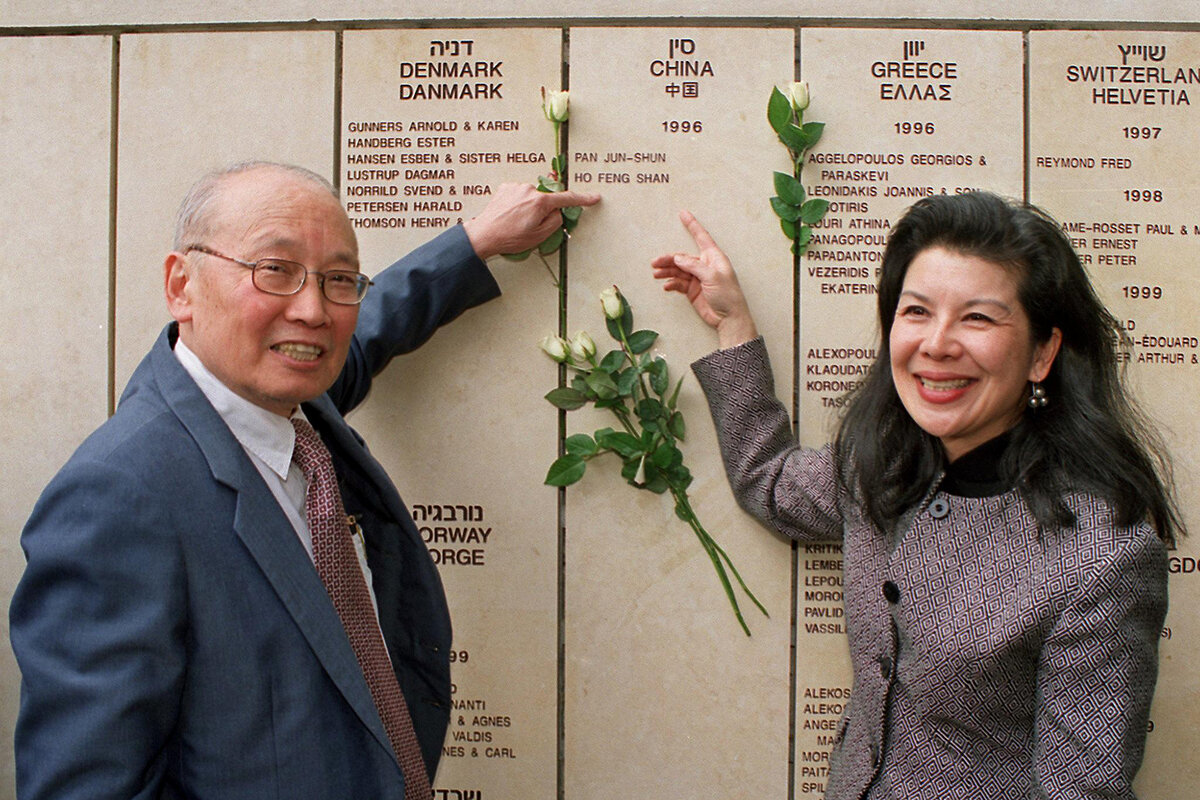
- Quick Read
- Deep Read ( 6 Min. )
In 1938, Chinese diplomat Ho Feng Shan witnessed the Nazi reign of terror descend on Austria. Jews were lining up outside his consulate, desperate to leave.
Mr. Ho, in defiance of his superior, issued them visas to Shanghai.
It was their ticket to safety.
On the eve of the 80th anniversary of the Holocaust, advocates are urging Congress to posthumously award Mr. Ho and 59 other diplomats a congressional gold medal for risking their careers and lives in ways that helped save an estimated hundreds of thousands of Jews.
Elisheva Lernau, who was rescued by British diplomat Frank Foley, once credited him as “a man of humanity in a time of unparalleled inhumanity.”
The House passed the bill in June, but the Senate has yet to vote on it. Proponents hope that elevating these stories will help a new generation gain a clearer picture of both the Holocaust’s devastation and the selfless heroism that accompanied it. Supporters say a rise in antisemitism makes honoring heroes of the Holocaust timely.
“We need to remember that we have to fight this evil anywhere we see it come up, and remember how it has impacted our world and past,” says Republican Sen. Pete Ricketts of Nebraska, a co-sponsor.
A different gold medal – for gentile diplomats who quietly saved Jews
In 1938, Chinese diplomat Ho Feng Shan witnessed a reign of terror descend on Austria.
Germany annexed the country in March, and the new Nazi government and its allies were attacking Jews on the streets, seizing their property, and arresting Jewish leaders. Even before the Kristallnacht pogrom that fall, Jews were lining up outside Mr. Ho’s consulate, desperate to leave – but unable to without an entry visa or boat ticket to another country.
Like many countries, China – which was at war with Japan, and seeking military and economic support from Hitler’s Germany – was not inclined to take in Jewish refugees. But unlike many other diplomats, Mr. Ho issued visas to Shanghai to anyone who asked him.
Some Jews used those visas, secured by Mr. Ho, to travel through the Soviet Union to China; others used the paperwork to get elsewhere, such as Cuba.
But for all, the Shanghai visa was the ticket to safety.
Now, on the eve of the 80th anniversary of the end of the Holocaust, advocates are urging Congress to posthumously award Mr. Ho and 59 other diplomats a congressional gold medal for risking their lives to save hundreds of thousands of Jews. The House passed the measure on June 11. If the Senate joins in passing it, a medal will be presented collectively to the families of those diplomats, and then be displayed in the U.S. Holocaust Memorial Museum in Washington.
Proponents say that they hope that elevating these stories will help a new generation gain a clearer picture of both the Holocaust’s devastation and the selfless heroism that accompanied it. The diplomats’ actions, they add, demonstrate the power of ordinary people acting according to conscience despite the personal risk or punishment they may face for doing so. And supporters of the bill say a rise in antisemitism makes honoring heroes of the Holocaust timely, especially amid a growing generational knowledge gap.
Nearly 10% of millennials have not heard of the Holocaust, according to a 2018 nationwide survey conducted by a nonprofit that pursues compensation for Holocaust survivors. In addition, it found that 41% of millennials thought 2 million or fewer Jews were killed, well below the actual death toll of 6 million. Nearly half could not name a single concentration camp, and even when presented with the name “Auschwitz” – the largest such camp, where more than 1 million Jews were killed – more than a third were not sure what it was.
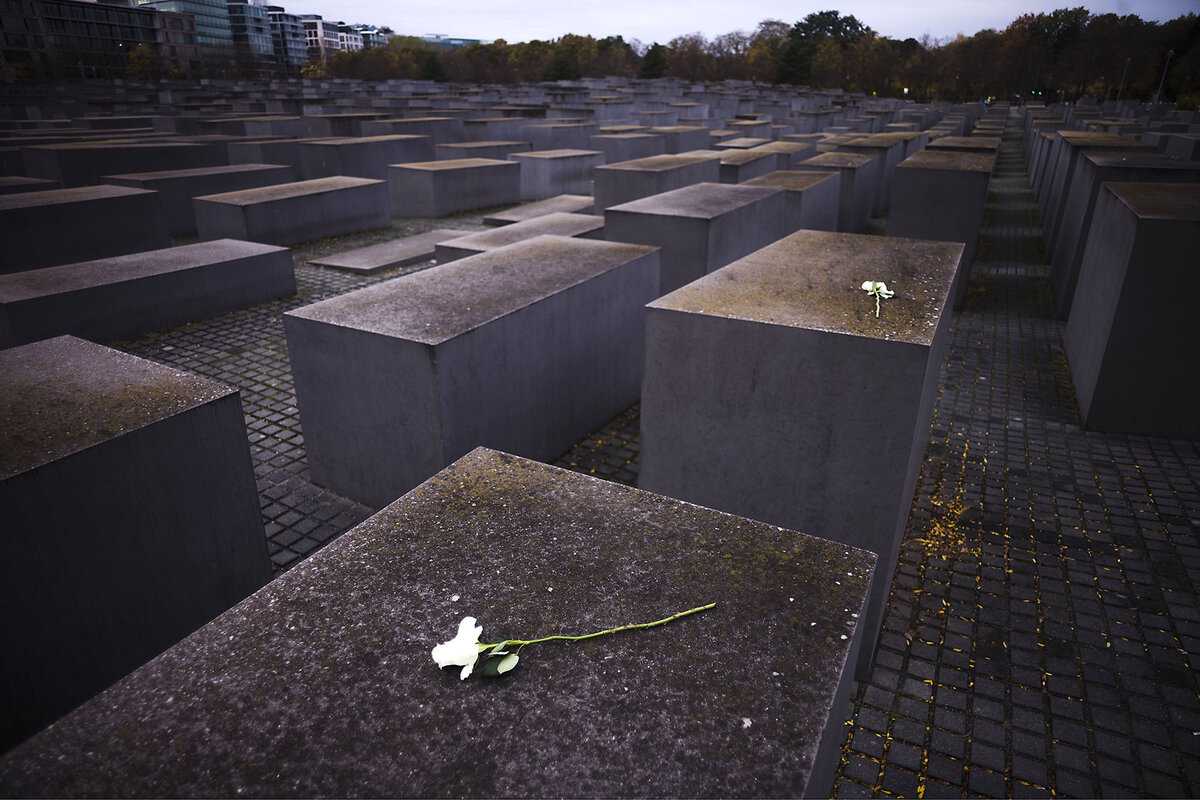
Meanwhile, in 2021, the number of antisemitic incidents in the U.S. hit their highest level since the Anti-Defamation League started tracking them more than 40 years ago. That number then more than tripled to 8,873 in 2023, with a spike following Hamas’ invasion of Israel on Oct. 7.
“We need to remember that we have to fight this evil anywhere we see it come up and remember how it has impacted our world and past,” says Sen. Pete Ricketts of Nebraska, a Republican co-sponsor of the bill.
Most of the 60 diplomats that the Forgotten Heroes of the Holocaust Congressional Gold Medal Act would recognize are relatively unknown. Very few sought or gained any recognition during their lifetimes for their courageous actions on behalf of Jews during the Holocaust, says Ezra Friedlander, CEO of the Friedlander Group, who lobbied for the act.
He credits the diplomats as individuals “who went out of their comfort zone and did something extraordinary to save people who they had no connection to – just that they were fellow human beings, sharing Planet Earth with them.”
There’s a larger lesson in everyday people making a difference with the skill sets they have, as these diplomats did, says Samantha Abramson, executive director at Nathan and Esther Pelz Holocaust Education Resource Center in Milwaukee.
“I look at it as an exercise in what democracy can and should be,” she says.
Quiet integrity
It didn’t take long for word of Mr. Ho’s defiance to spread, according to records of Mr. Ho and his actions available through Holocaust organizations, including Israel’s Yad Vashem Holocaust memorial in Jerusalem. When his supervisor in Berlin caught wind of what the Chinese diplomat was doing, he ordered him to stop. A few months later, the Nazi government claimed that Mr. Ho’s consulate was a Jewish-run building and shut it down.
When Mr. Ho asked the Chinese government for funds for a new office, he was refused. So he paid for a new building out of his own pocket, continuing to give out visas to any Jews who asked him. He also took to walking Jewish families home and sometimes staying with them, so his diplomatic status could protect them from violence.
In 1939, Mr. Ho received a demerit, or censure, and was reassigned to New York the following year. He continued his diplomatic career until his retirement in 1973, but he was denied his pension.
Mr. Ho rarely spoke about his time in Austria, but a 2007 op-ed by his daughter in a Chinese newspaper gave some insight into his motives. Following a century of foreign imperialism in China and the humiliation that brought, she wrote, he was “very sensitive to persecution and to the bullying of any peoples.”
After his death, Mr. Ho has sometimes been hailed as “China’s Schindler,” a reference to Oskar Schindler, a German industrialist who saved more than 1,000 Jews by employing them in his factories.
Defying the law
“The Oskar Schindler of Brazil,” who served as ambassador to France during the Nazi occupation, similarly issued visas illegally. In contrast to Mr. Ho, however, Luis Martins de Souza Dantas issued a passionate verbal defense of what he had done.
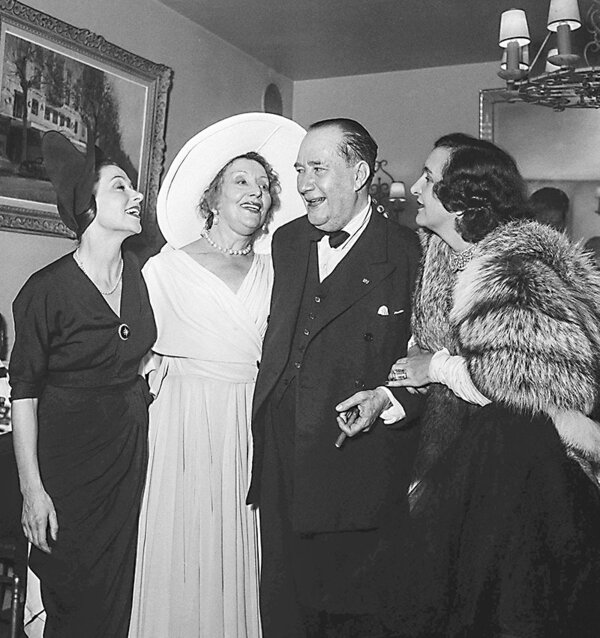
At that time, Brazil secretly banned Jewish immigrants. That did not stop Mr. Souza Dantas from issuing hundreds of visas to Jews seeking to escape the Nazis. When he received complaints, he simply marked visas with a date before the complaints.
In 1941, the Brazilian government opened an inquiry into his actions. In response, Mr. Souza Dantas wrote, “I did what, given the nobility of soul of the Brazilians, the most cold-hearted of them would have done, moved by the most elementary sentiments of Christian piety.”
He was able to avoid a trial on a technicality.
An unlikely spy
Capt. Frank Foley is another example of unwavering defiance – but he ran an even stronger risk than Mr. Schindler, who was needed for the German war effort, or the two diplomats, Mr. Ho or Mr. Souza Dantas, who could have claimed diplomatic immunity.
Mr. Foley served as Britain’s top spy in Berlin during the war. His cover job as head of the British Passport Control office in Germany enabled him to help an estimated 10,000 Jews escape Nazi rule.
Mr. Foley and his wife also hid Jews in their apartment, and he sometimes even entered concentration camps to save people imprisoned there by presenting false visas to the guards.
One of those whom he rescued, Elisheva Lernau, was present in 2004 when Mr. Foley was honored at the British Embassy in Berlin.
“I owe my life to this man I never met, a man of humanity in a time of unparalleled inhumanity,” she said.
Mr. Foley acted in defiance of both German and British law. Had he been caught, his status as a spy would have stripped him of diplomatic immunity, and he could have been imprisoned or executed.
Proponents of the bill say that they want to remember the antisemitism of the past and address its threat today. “The world will forever grapple with the dark questions of the Holocaust,” said Virginia Sen. Tim Kaine, the original Democratic co-sponsor, in a statement.
The bill's supporters hope to shine a light on the heroes as well.

How surfing helped me conquer corporate burnout
When you’re used to playing the expert, diving into the unknown can be daunting. But as our essayist learns, being a novice can be exhilarating.

- Quick Read
- Deep Read ( 4 Min. )
-
By Marisol Trowbridge Contributor
My heart pounded as I hauled my surfboard to the water’s edge. Out past the cresting waves, experienced surfers bobbed on slim boards, waiting for a well-formed peak. They’d paddle hard, racing the swells and leaping to stand in time to soar along the glossy face of each curl. I longed to master such grace.
“Are you ready?” my instructor asked.
No, not at all, not even a little. I swallowed, following the instructor’s gaze to the roaring, 5-foot breakers pounding the beach. The hairs on my arms rose.
“Let’s go!”
I crossed my first wave, arms wheeling. My board erupted from the sea, catapulting me straight into the churn. Again and again.
Yet I wasn’t frustrated. Between the wrestling of boards and my tumbles with seaweed, I’d found a nonjudgmental curiosity about my experience that kept me going, even bruised and waterlogged.
Whether the next wave knocked me off course or became the best ride of my life, I didn’t need to know what was coming. The mastery is in the process of discovery and response, of finding a way forward, whatever comes.
How surfing helped me conquer corporate burnout
As a corporate strategist, I’m used to showing up with authority, presenting data-heavy charts and hard-hitting PowerPoint presentations to influential executives. Playing the expert is an exhausting business. Which is why, on a much-needed Costa Rican sabbatical, I felt particularly out of my depth as I stood on a stretch of piping hot sand as a rank beginner, a 9-foot foam surfboard tucked under my arm.
My heart pounded as I hauled my badge of dishonor to the water’s edge. At work, being unsure felt like a liability, winding me up tight. Here, it was plain embarrassing, with the entire beach watching.
Out past the cresting waves, experienced surfers bobbed on small, slim boards, waiting for a well-formed peak. They’d paddle hard, racing the swells and leaping to stand in time to soar along the glossy face of each curl. I longed to master such grace.
“Are you ready?” my instructor asked.
No, not at all, not even a little. It’d been too long since I tried something new, my busy career demanding single-minded focus. I swallowed, following the instructor’s gaze to the roaring, 5-foot breakers pounding the beach. The hairs on my arms rose.
“Let’s go!” My answer surprised me, but I meant it. I loved the beauty and power of the ocean and dreamed of harnessing its elemental energy. I’d burned through my own years ago.
My instructor demonstrated how to push the board through the waves, while walking with “the stingray shuffle,” rubbing feet over sand to create vibrations that would tell any burrowed rays to flee my approach. When we were finally waist-deep, he showed me how to turn and ride back to shore on my belly.
The next time, we shuffled out till I was chest-deep, and my instructor told me to climb onto my board. I put both hands on the deck of my board and jumped, landing with a wet thud on my stomach. A wall of white water swiftly filled in behind, and I paddled, gaining speed.
Pushing up, I swung wobbly legs beneath me, forgetting any embarrassment in my toddlerlike delight at standing on my board for the first time. I promptly toppled off. After a few more false starts, I zipped weightless toward shore.
The rush was over too fast, and I fell, smashing my tailbone into the soft sand. But it didn’t hurt. I leaped up, hurrying back in for my next thrilling ride.
Nothing would stop me now.
“Remember the stingray shuffle!” my instructor called. I forced myself to slow, eager to try again – and again.
This, I learned, is the power of a beginner’s mind. Failures become steppingstones to success. Setbacks transform into lessons. Wonder heightens the senses, and the delight of newness ignites play and exploration.
Slowly, I progressed. I learned to stroke through the onslaught of waves to get “out the back,” reaching the coveted calm beyond the break where real surfers commune. I practiced reading swells until I could predict their arrival and speed. Finally, I caught my first ride, surging along a crest of pure ocean fire. My heart soared like the pelicans above. I was no longer a novice.
But I was not yet a master. Most waves rammed me feet-over-head through an underwater wringer till I struggled up for air. The awe of newness receded. I contemplated quitting. I’d never become an ace, dancing on a board so small it’s called a fish. But I wanted to taste their freedom. So I carried on.
After weeks of practice, my movements grew fluid. I rode more, fell less. And then, at last, my instructor offered something new. A Malibu longboard, it was bright and sleek. Forget foam; I could add wax. Now I was getting somewhere. I pranced down the beach with my prize.
I knew the drill. Shuffle to chest-deep. Paddle through incoming breakers. Head for the deep blue.
I crossed my first inbound wave, arms wheeling. But my new board erupted from the sea, catapulting me straight into the churn. Resurfacing, I tried to grab the beast, but the slippery thing swished away as I attempted mounting. With a rueful grin, I gave chase.
What would come next, backflips?
Yet I wasn’t frustrated. Sometime since my first day surfing, between the wrestling of boards and my tumbles with seaweed, I’d found a nonjudgmental curiosity about my experience that kept me going, even bruised and waterlogged. Perhaps I’d tasted the seasoned surfers’ freedom after all.
Panting, I caught the board, dragging myself on top to take a beat. Then I looked up.
Another watery rampart was already bearing down.
“Will we make it?” I whispered to myself, fervently paddling, still gasping from my last adventure. But I knew I’d come out the other side, one way or another. The thought filled me with an energizing peace, one I’d take with me when I left Costa Rica.
Whether the next wave knocked me off course or became the best ride of my life, I didn’t need to know exactly what was coming. I’d never be the expert; not even the aces knew the next wave in advance. Fresh challenges kept rolling in, each one filled with possibility and opportunities for growth.
Suddenly, my career looked a little different. Sure, I have an expertise, but I don’t need to be “the expert.” The mastery is in the process of discovery and response, of finding a way forward, whatever comes.
Other headline stories we’re watching
(Get live updates throughout the day.)The Monitor's View
An eternal lift from the 2024 Olympics
- Quick Read
- Deep Read ( 2 Min. )
-
By the Monitor's Editorial Board
The 2024 Paris Olympics may be over, but one heartwarming video has gone viral. It shows the medal ceremony for the floor exercise of women’s gymnastics in which the gold medal winner, Brazilian Rebeca Andrade, receives a bow from the two other women on the platform.
Moments like these at the Olympics create memories of athletes cheering for one another and hugging. Fans mimic this behavior despite being from various countries. In Paris, most stood for the playing of the national anthem of every country that won.
Three years ago, when COVID-19 delayed and altered the Summer Olympics, these celebrations didn’t happen. For these Games, at least 6 million people descended on the French capital for a cool two-week delight in sporting excellence.
Three-time shot put gold medal winner Ryan Crouser says the closing ceremony is the best part. “Coming together through sport and finding what unites us, competing in a friendly way, and just seeing a unity amongst athletes with so many smiles and so many memories being made” are what make the experience priceless, he says.
The Games are not a distraction from daily life. They are a way to lift every person’s life with moments of eternal glory and gratitude.
An eternal lift from the 2024 Olympics

The 2024 Paris Olympics may be over, but one heartwarming video has gone viral on social media. It shows the medal ceremony for the floor exercise of women’s gymnastics. The two Americans, Simone Biles and Jordan Chiles, bow to the gold medal winner, Brazilian Rebeca Andrade, who smiles, raises her hands, and then poses for pictures with the pair and hugs them. [The bronze medal is still in dispute.] The moment was the first time that three Black medalists had ever shared the podium in the sport, and the crowd loved it.
Moments like these at the Olympics create memories of athletes cheering for one another and hugging. Fans mimic this behavior despite being from various countries. In Paris, most stood for the playing of the national anthem of every country that won. They decked themselves out in national attire and partied in the streets.
Three years ago, when COVID-19 delayed and altered the Summer Olympics, these celebrations didn’t happen. Even this year, turmoil from wars, natural disasters, and political shake-ups have turned many people off from each other and made them unwilling to celebrate. Nonetheless, at least 6 million people descended on the French capital for a cool two-week delight in sporting excellence.
There were many firsts at these Games. Gymnast Carlos Yulo was the Philippines’ first male athlete to win Olympic gold. The Caribbean island of Dominica won its first Olympic medal when Thea LaFond won the women’s triple jump. Athletes were celebrated, win, lose, or draw. At the closing ceremony, newly formed friendships of athletes were on display as they stood shoulder to shoulder with renewed spirits.
Three-time shot put gold medal winner Ryan Crouser says the closing ceremony is the best part of the Olympics because it represents the best of every athlete. “Coming together through sport and finding what unites us, competing in a friendly way, and just seeing a unity amongst athletes with so many smiles and so many memories being made” are what make the experience priceless, Mr. Crouser says. “Regardless of how the athlete performed – you have a select few that won a medal – but everyone there is happy to have that Olympic experience.”
With people the world over often at odds, an event like the Olympics shows that competitors can be friends. The Games are not a distraction from daily life. They are a way to lift every person’s life with moments of eternal glory and gratitude.

A Christian Science Perspective
Each weekday, the Monitor includes one clearly labeled religious article offering spiritual insight on contemporary issues, including the news. The publication – in its various forms – is produced for anyone who cares about the progress of the human endeavor around the world and seeks news reported with compassion, intelligence, and an essentially constructive lens. For many, that caring has religious roots. For many, it does not. The Monitor has always embraced both audiences. The Monitor is owned by a church – The First Church of Christ, Scientist, in Boston – whose founder was concerned with both the state of the world and the quality of available news.
A way out of addiction
- Quick Read
- Read or Listen ( 1 Min. )
Glimpsing the spiritual nature of existence frees us from downward cycles.
A way out of addiction
Trapped. That’s how we might feel if we’re hooked on a substance or harmful activity. Coping or resignation can be two responses. But no matter which approach we take, we always have a yearning for freedom.
Many individuals have broken away from troubling, even dangerous, habits by deepening their understanding of our divine Parent, God. We’ve compiled several pieces from the archives of The Christian Science Publishing Society that share how we can find a brighter horizon through the spiritual sense of life that God gives.
In “‘I feel like I can’t quit,’” the author explains that we don’t have to force ourselves to stop a bad habit – progress can come naturally, as we learn that we’re wholly good, God’s beloved offspring.
“‘Charity begins at home’” shows that shifting to a spiritual perspective reveals our loved ones’ true free nature, as the author found when his dad overcame alcoholism.
“Freedom from addiction to sleep medication” explores how we can wake up from fear-driven patterns and discover that divine Love is always embracing us.
And the author of “Healed of drug addiction and hemorrhoids” highlights how understanding our true, spiritual identity as God’s children brings physical healing and enables us to exchange addiction for freedom.

Viewfinder
Merci, Paris! And hello, LA.

A look ahead
Thanks for starting a new week with us. Tomorrow we’ll look at the rash of U.S. election-related deepfake videos being generated by artificial intelligence – and at how to spot them.
Also: “I’m nostalgic for the Games already.” That was Paris-based Peter Ford, our international news editor, at today’s staff meeting. If you feel that way, too, find our complete coverage here.



